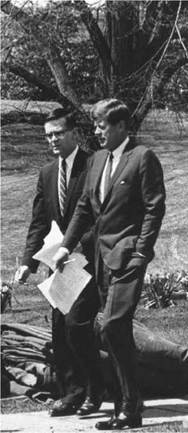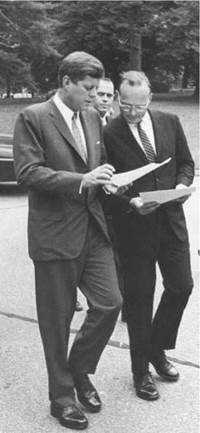NASA’s Budget Reviewed
Budget director David Bell in February issued a government-wide call for a rapid agency review of the proposed Fiscal Year (FY) 1962 budget that had been submitted by the outgoing Eisenhower administration. James Webb’s initial examination of the NASA budget convinced him that the Eisenhower proposal was not adequate to support the kind of space program he believed was appropriate for the Kennedy administration; he judged that there was a need to accelerate the pace of the milestones that had been set out in NASA’s then-current ten-year plan. For example, he wanted to move the date of a potential lunar landing mission forward from 1973 to 1970; George Low’s report had indicated that it would be possible by that year, and perhaps even sooner. On March 17, NASA submitted a request for an additional $308.2 million, a 30 percent increase over the $1,109.6 million budget in the Eisenhower request. In his budget submission, Webb argued that “the civilian space program clearly can achieve a much more substantial contribution in aeronautical research and space exploration and technology if the pace of the program for 1962 is substantially accelerated.”18
Budget director Bell did not think that either he or the president was ready to decide on such an acceleration of NASA’s efforts. He later recalled that “most of us, when we came into office didn’t have any notion of what the space program was all about, what the issues were. A lot of people needed to be educated.”19 In response to the NASA request, BOB indicated that it would approve only a $50 million increase in the NASA budget, with any additional increases deferred until fall 1961, after a comprehensive review of the NASA program had been completed. James Webb refused to accept BOB’s decision and, as was his right as the head of a government agency, asked for a meeting with the president to appeal his case for a larger increase. The meeting was set for the late afternoon of March 22.
Before meeting with the president, Webb, Dryden, and Seamans briefed Vice President Johnson on their budget request. Budget director Bell, his deputy Elmer Staats, and the top career BOB staff person for the NASA
budget, Willis Shapley, explained to the vice president why they had not approved most of the request. In preparation for this meeting, Edward Welsh had prepared a briefing memorandum for Johnson that noted that the “major policy issue” involved in the budget was “does this country want to make an effort to catch up to the Soviet Union in space capability,” and particularly in weight-lifting capability. “To a considerable extent, domination of space will belong to those who can put up large manned and unmanned vehicles,” suggested Welsh.20
 |
 |
After this initial discussion, President Kennedy, Jerome Wiesner, the president’s national security adviser, McGeorge Bundy, and chairman of the Atomic Energy Commission Glenn Seaborg joined the meeting in the White House cabinet room. Bundy had not been named to his post until January, making him one of the last people to join Kennedy’s White House inner
President Kennedy with two of his top advisors on space issues, special counsel Theodore Sorensen (left image) and special assistant for national security affairs McGeorge Bundy (right image). (JFK Library photos)
circle. He was a Yale-educated member of the Republican Eastern establishment who had become a Harvard professor of government with a widely acknowledged intellect, and then in 1953, at age 34, the youngest ever dean of the Harvard faculty. Bundy during the Kennedy administration was to play an important role in the national security dimensions of the U. S. space effort, including the race to the Moon.
The BOB had prepared an agenda for the meeting that indicated that “the future direction and level of the civilian space program primarily depends on decisions to be made by this administration concerning the rate [at which] it wishes to undertake the following: (1) Increasing the rate of closure on the USSR’s lead in weight lifting capability; (2) Advancing manned exploration of space beyond Project Mercury.” Each of these issues, said the BOB paper, “merits assessment in relation to its (1) technological significance, (2) impact on the international prestige of the United States, and (3) effect on present and future budget requirements.” With respect to agenda item 2, the question was “should we now launch an aggressive program of manned space exploration to follow Mercury, aimed at the progressive goals of (a) multimanned orbital laboratory and later (b) manned circumlunar flight and (c) manned lunar landing?”21
James Webb had stayed up late the day before the meeting preparing a six-page talking paper. He argued that “U. S. procrastination for a number of years had been based in part on a very real skepticism by President Eisenhower personally as to the necessity for the large expenditures required, and the validity of the goals sought through the space effort.” Webb noted that “in the preparation of the 1962 budget, President Eisenhower reduced the $1.35 billion requested by the Space Agency to the extent of $240 million and specifically eliminated funds to proceed with manned space flight projects beyond Mercury. This decision emasculated the ten year plan before it was even one year old, and unless reversed guarantees that the Russians will, for the next five to ten years, beat us to every spectacular exploratory flight.” Webb told Kennedy that “the first priority of this country’s space effort should be to improve as rapidly as possible our capability for boosting large spacecraft into orbit.” He added that “the Soviets have demonstrated how effective space exploration can be as a symbol of scientific progress and as an adjunct of foreign policy. Without necessarily following the Soviet lead in this kind of exploitation, we should not fail to recognize its potential.” Webb closed his paper by suggesting that leadership in space, “pioneering on a new frontier,” would help to create “more viable political, social and economic systems for nations willing to work with us in the years ahead.”22 These were themes that Webb realized would resonate with John Kennedy.
Robert Seamans followed Webb’s remarks with a concise summary of NASA’s budget request. Kennedy told Seamans: “That was very good; I would like your views in writing tomorrow.”23 With that, the hour-and-a – half meeting concluded. During those 90 minutes, John Kennedy, perhaps for the first time, had had the chance to get a clear picture of the space policy and budget issues requiring his decision.
Webb then briefly went into the Oval Office with President Kennedy and Vice President Johnson. He assured them, as the newcomer to the NASA leadership, that he believed “that we were moving right ahead with the things that needed to be done”; Kennedy in return told Webb that Dryden and Seamans had made a positive impression on him at this, their first meeting. Meanwhile, Seamans went home and prepared the memorandum that Kennedy had requested, which Webb quickly forwarded to the White House.24










